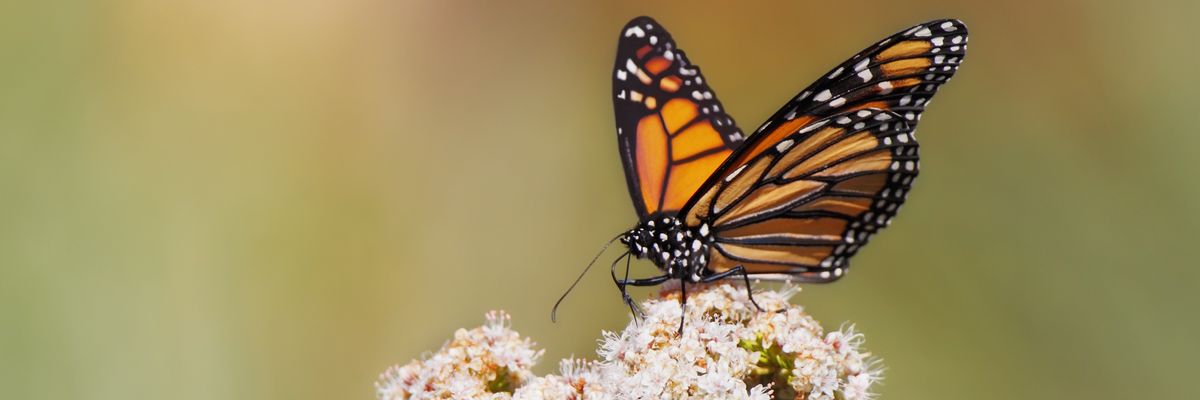
A monarch butterfly perched on wildflower blossoms.
'Catastrophic and Saddening': Research Shows US Butterfly Population Dropped 22% in Two Decades
"It's pretty shocking, really, that we've lost that much biodiversity in such a short time," said one of the study authors.
A landmark study released Thursday in the journal Science found that the number of butterflies in the United States declined dramatically between 2000 and 2020.
"The prevalence of declines throughout all regions in the United States highlights an urgent need to protect butterflies from further losses," according to the abstract of the study, which was authored by over 30 researchers from around the country.
Between 2000 and 2020, total butterfly abundance in the contiguous United States fell by 22% across 554 recorded species. The study also reported widespread species-level decline, in addition to overall abundance decline. According to researchers, 13 times as many butterfly species are declining as they are increasing.
"It's pretty shocking, really, that we've lost that much biodiversity in such a short time," said Eliza Grames, a conservation biologist at Binghamton University in New York and one of the study authors, who spoke with WBUR about the findings.
The survey used data from multiple sources, including North American Butterfly Association, which is the "longest-running volunteer-based systematic count of butterflies in the world," as well as data from Massachusetts Butterfly Club, which "carries out organized field trips and records individuals' reports across the state in which participants identify and record butterflies seen."
Scientists and dedicated amateur enthusiasts helped collect the data, according to The Washington Post, which spoke with some of the researchers.
"Scientists could not get all the data we used," Nick Haddad, an ecologist and conservation biologist at Michigan State University who worked on the study, per the Post. "It took this incredible grassroots effort of people interested in nature."
The study identified pesticide use, climate change, and habitat loss as drivers of the decline.
The research echoes other scientific findings that have recorded widespread loss of insect abundance more generally, a phenomenon that's sometimes called the "insect apocalypse." Bugs do many important things, like pollinating crops and keeping soil healthy. "As insects become more scarce, our world will slowly grind to a halt, for it cannot function without them," wrote biologist Dave Goulson in 2021.
Entomologist David Wagner, who was not involved in the study, told the Post in an email that butterflies function as a "yardstick for measuring what is happening" among insects generally. He said the findings of the study were "catastrophic and saddening."
An Urgent Message From Our Co-Founder
Dear Common Dreams reader, The U.S. is on a fast track to authoritarianism like nothing I've ever seen. Meanwhile, corporate news outlets are utterly capitulating to Trump, twisting their coverage to avoid drawing his ire while lining up to stuff cash in his pockets. That's why I believe that Common Dreams is doing the best and most consequential reporting that we've ever done. Our small but mighty team is a progressive reporting powerhouse, covering the news every day that the corporate media never will. Our mission has always been simple: To inform. To inspire. And to ignite change for the common good. Now here's the key piece that I want all our readers to understand: None of this would be possible without your financial support. That's not just some fundraising cliche. It's the absolute and literal truth. We don't accept corporate advertising and never will. We don't have a paywall because we don't think people should be blocked from critical news based on their ability to pay. Everything we do is funded by the donations of readers like you. Will you donate now to help power the nonprofit, independent reporting of Common Dreams? Thank you for being a vital member of our community. Together, we can keep independent journalism alive when it’s needed most. - Craig Brown, Co-founder |
A landmark study released Thursday in the journal Science found that the number of butterflies in the United States declined dramatically between 2000 and 2020.
"The prevalence of declines throughout all regions in the United States highlights an urgent need to protect butterflies from further losses," according to the abstract of the study, which was authored by over 30 researchers from around the country.
Between 2000 and 2020, total butterfly abundance in the contiguous United States fell by 22% across 554 recorded species. The study also reported widespread species-level decline, in addition to overall abundance decline. According to researchers, 13 times as many butterfly species are declining as they are increasing.
"It's pretty shocking, really, that we've lost that much biodiversity in such a short time," said Eliza Grames, a conservation biologist at Binghamton University in New York and one of the study authors, who spoke with WBUR about the findings.
The survey used data from multiple sources, including North American Butterfly Association, which is the "longest-running volunteer-based systematic count of butterflies in the world," as well as data from Massachusetts Butterfly Club, which "carries out organized field trips and records individuals' reports across the state in which participants identify and record butterflies seen."
Scientists and dedicated amateur enthusiasts helped collect the data, according to The Washington Post, which spoke with some of the researchers.
"Scientists could not get all the data we used," Nick Haddad, an ecologist and conservation biologist at Michigan State University who worked on the study, per the Post. "It took this incredible grassroots effort of people interested in nature."
The study identified pesticide use, climate change, and habitat loss as drivers of the decline.
The research echoes other scientific findings that have recorded widespread loss of insect abundance more generally, a phenomenon that's sometimes called the "insect apocalypse." Bugs do many important things, like pollinating crops and keeping soil healthy. "As insects become more scarce, our world will slowly grind to a halt, for it cannot function without them," wrote biologist Dave Goulson in 2021.
Entomologist David Wagner, who was not involved in the study, told the Post in an email that butterflies function as a "yardstick for measuring what is happening" among insects generally. He said the findings of the study were "catastrophic and saddening."
A landmark study released Thursday in the journal Science found that the number of butterflies in the United States declined dramatically between 2000 and 2020.
"The prevalence of declines throughout all regions in the United States highlights an urgent need to protect butterflies from further losses," according to the abstract of the study, which was authored by over 30 researchers from around the country.
Between 2000 and 2020, total butterfly abundance in the contiguous United States fell by 22% across 554 recorded species. The study also reported widespread species-level decline, in addition to overall abundance decline. According to researchers, 13 times as many butterfly species are declining as they are increasing.
"It's pretty shocking, really, that we've lost that much biodiversity in such a short time," said Eliza Grames, a conservation biologist at Binghamton University in New York and one of the study authors, who spoke with WBUR about the findings.
The survey used data from multiple sources, including North American Butterfly Association, which is the "longest-running volunteer-based systematic count of butterflies in the world," as well as data from Massachusetts Butterfly Club, which "carries out organized field trips and records individuals' reports across the state in which participants identify and record butterflies seen."
Scientists and dedicated amateur enthusiasts helped collect the data, according to The Washington Post, which spoke with some of the researchers.
"Scientists could not get all the data we used," Nick Haddad, an ecologist and conservation biologist at Michigan State University who worked on the study, per the Post. "It took this incredible grassroots effort of people interested in nature."
The study identified pesticide use, climate change, and habitat loss as drivers of the decline.
The research echoes other scientific findings that have recorded widespread loss of insect abundance more generally, a phenomenon that's sometimes called the "insect apocalypse." Bugs do many important things, like pollinating crops and keeping soil healthy. "As insects become more scarce, our world will slowly grind to a halt, for it cannot function without them," wrote biologist Dave Goulson in 2021.
Entomologist David Wagner, who was not involved in the study, told the Post in an email that butterflies function as a "yardstick for measuring what is happening" among insects generally. He said the findings of the study were "catastrophic and saddening."

